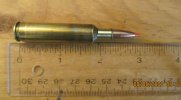COW but coffee sounds nicer - bullets are pricy.
The Ackley Improved chamber is slightly shorter than the parent case to alow for a crush fit and closing the bolt on an unformed case might be impossible, should the chamber be not deep enough - excessive brass length, crush fit won't work, bolt lugs not intended to size brass. My solution is to grind down an extra shell holder that will allow more case compression so unformed brass may have the desired crush fit. I keep the ground down shell holder in my AI die box with the dies. In any event a crush fit is essential, keep the case base snug against the bolt face. Go easy to prevent case buckling when initially sizing down.
I use pistol primers for COW fire forming. I'm guessing that 25-30 K psi will result in a nice sharp shoulder. Large pistol primers are more available than large rifle primers - save those valuable large rifle primers.
I use any kind of pistol powder for COW fire forming. Best to start with 10% of entire weight of full case load. Most often the final fire form load will be 12%-15%.
Fireforming without COW has not worked for me.
I COW fireform inside my garage. I use a 5 ft long piece of PVC (white) 3-inch diameter pipe capped at one end. I bunge cord the pipe to a step ladder. The barrel of the rifle is placed inside the pipe & the COW round fired - sounds like THUD, blast absorbed by pipe. Dump the waste out of pipe after 10 or so rounds. Clean chamber after each firing to prevent case dents caused by COW crud caught between brass & chamber. Ventilate the space well - don't suck in lead primer fumes.
After all that I check for brass length & turn necks. My favorite is the 6mm AI, I keep about 200 pieces of 6mm AI brass on hand for rodent shooting. Ackey Improved cases are worthy of the effort. A 6mmRem to 6mm AI provides about 10% more case capacity. 87 VMax at just under 3,500 fps. Annealed after fire forming.

I also make .280 Rem cases out of .270 Win using the false shoulder method.
COW fire forming will blow out case necks, so they are nice & concentric. 7mm Mag to .375-.338




